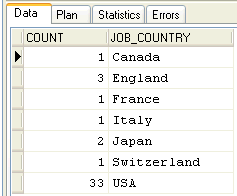InterBase Quick Start: Part IV - Using the GROUP BY Clause
Go Up to InterBase Quick Start: Part IV - Grouping and Ordering Query Results
You use the optional GROUP BY clause to organize data retrieved from aggregate functions. When you issue a query (a SELECT statement) that has both aggregate (AVG, COUNT, MIN, MAX, or SUM) and non-aggregate columns, you must use GROUP BY to group the result set by each of the nonaggregate columns. The three following rules apply:
- Each column from which you are doing a nonaggregate SELECT must appear in the GROUP BY clause.
- The GROUP BY clause can reference only columns that appear in the SELECT clause.
- Each SELECT clause in a query can have only one GROUP BY clause.
A group is defined as the subset of rows that match a distinct value in the columns of the GROUP BY clause.
 Grouping the Result Set of Aggregate Functions
Grouping the Result Set of Aggregate Functions
- Execute the following query to find out how many employees there are in each country:
SELECT COUNT(emp_no), job_country FROM Employee
GROUP BY job_country
- The result set should look like this:
